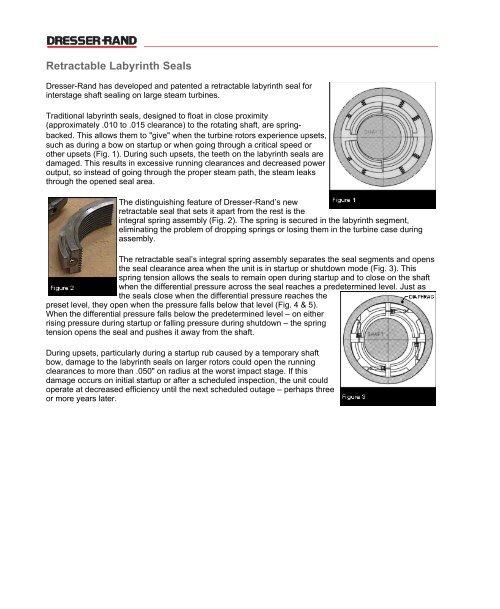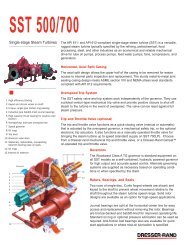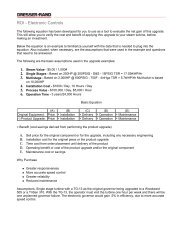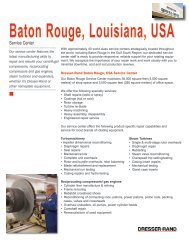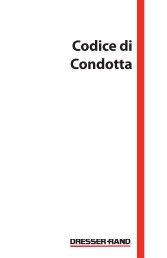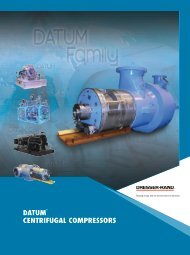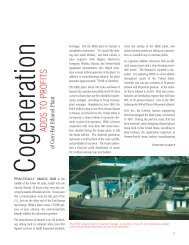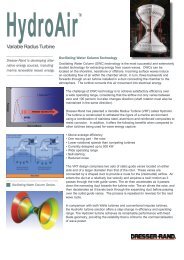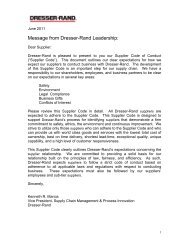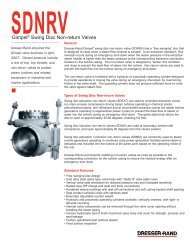Retractable Labyrinth Seals - Dresser-Rand
Retractable Labyrinth Seals - Dresser-Rand
Retractable Labyrinth Seals - Dresser-Rand
You also want an ePaper? Increase the reach of your titles
YUMPU automatically turns print PDFs into web optimized ePapers that Google loves.
<strong>Retractable</strong> <strong>Labyrinth</strong> <strong>Seals</strong><br />
<strong>Dresser</strong>-<strong>Rand</strong> has developed and patented a retractable labyrinth seal for<br />
interstage shaft sealing on large steam turbines.<br />
Traditional labyrinth seals, designed to float in close proximity<br />
(approximately .010 to .015 clearance) to the rotating shaft, are springbacked.<br />
This allows them to "give" when the turbine rotors experience upsets,<br />
such as during a bow on startup or when going through a critical speed or<br />
other upsets (Fig. 1). During such upsets, the teeth on the labyrinth seals are<br />
damaged. This results in excessive running clearances and decreased power<br />
output, so instead of going through the proper steam path, the steam leaks<br />
through the opened seal area.<br />
The distinguishing feature of <strong>Dresser</strong>-<strong>Rand</strong>’s new<br />
retractable seal that sets it apart from the rest is the<br />
integral spring assembly (Fig. 2). The spring is secured in the labyrinth segment,<br />
eliminating the problem of dropping springs or losing them in the turbine case during<br />
assembly.<br />
The retractable seal’s integral spring assembly separates the seal segments and opens<br />
the seal clearance area when the unit is in startup or shutdown mode (Fig. 3). This<br />
spring tension allows the seals to remain open during startup and to close on the shaft<br />
when the differential pressure across the seal reaches a predetermined level. Just as<br />
the seals close when the differential pressure reaches the<br />
preset level, they open when the pressure falls below that level (Fig. 4 & 5).<br />
When the differential pressure falls below the predetermined level – on either<br />
rising pressure during startup or falling pressure during shutdown – the spring<br />
tension opens the seal and pushes it away from the shaft.<br />
During upsets, particularly during a startup rub caused by a temporary shaft<br />
bow, damage to the labyrinth seals on larger rotors could open the running<br />
clearances to more than .050" on radius at the worst impact stage. If this<br />
damage occurs on initial startup or after a scheduled inspection, the unit could<br />
operate at decreased efficiency until the next scheduled outage – perhaps three<br />
or more years later.
For example, assume you have a 20MW turbine generator that produces electricity with an evaluation of<br />
$.04 per kilowatt. Based on a 16-inch shaft diameter and a 16-stage machine, the efficiency loss due to the<br />
opened clearance could be close to 2.5 percent for a .050 rub – versus normal operating clearance of .010"<br />
on radius. Using the $.04 KW evaluation and 8,000 hours of operation per year, running with the damaged<br />
seals would cost approximately $160,000 per year in lost power. The differential cost of the <strong>Dresser</strong>-<strong>Rand</strong><br />
retractable seals over traditional "floating" seals would be covered in less than one year of operation.<br />
Contact your local <strong>Dresser</strong>-<strong>Rand</strong> representative, or call us at 1-800-275-3773 (inside the United States) or<br />
716-593-1234 (outside the United States) to obtain a quote on upgrading your steam turbine with <strong>Dresser</strong>-<br />
<strong>Rand</strong>’s retractable seals.<br />
Form 2013<br />
Copyright 2001 <strong>Dresser</strong>-<strong>Rand</strong>


